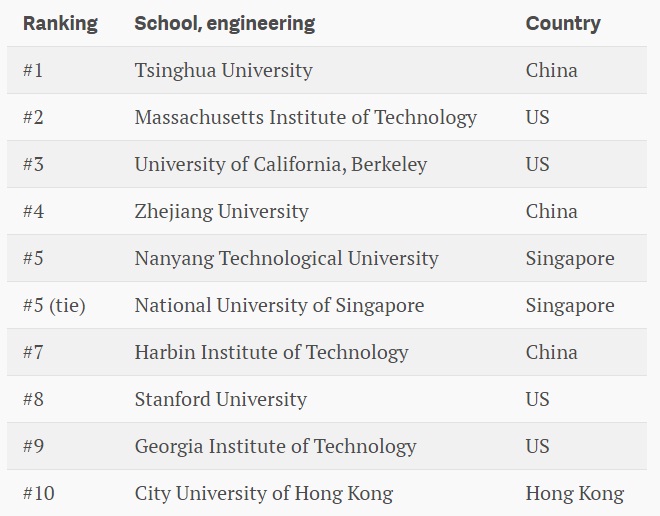MIT is unambiguously the more prestigious and well known of the two, especially outside of China, so how could Tsinghua have overtaken it? The answer is quantity, not quality. And we’re not talking student quality here, but research papers.
US News rankings by subject try to determine the best schools in a particular field, like engineering or economics. For the hard sciences, the subject ranking relies almost exclusively on a university’s research output. It is based on how much research each university produces, measures of how good that research is, and the level of international cooperation. This is different from the US News ranking for schools overall, which include indicators like the number of conferences held, books published, and PhDs awarded.
Chinese schools are indeed climbing the engineering list. Tsinghua drew attention for besting MIT, and two other Chinese universities appeared in the top 10. But while these schools score big in the “how much” categories, they do poorly on the “how good” ones.

In the engineering category, Tsinghua was ranked number ones for “total publications,” meaning its name was attached to more engineering papers than any other institution. But in “normalized citation impact” – a measure of citations per paper that accounts for differences in publication year and research area – it ranked a paltry 186. On another qualitative category, “percentage of total publications among the 10% most cited,” it came in at 167.
Tsinghua’s “global research reputation,” a measure based on surveys of researchers in a particular field, was number 16 in the world, a respectable but not outstanding number. MIT remained number one in that category, followed by UC Berkeley, Stanford, and Caltech.
The same pattern applies to the other Chinese universities in the engineering top 10. Zhejiang University, number four on the final list, was third in total publications but 110 in global research reputation. Harbin Institute of Technology, the seventh-best engineering school according to US News, was number two in total citations and number four in total publications, but 130 in reputation and 157 in publications among the 10% most cited.
The quantity explanation shows that these universities still have a long way to go to match the prestige of their counterparts in the US. The US News data show, for example, that Chinese universities attract far fewer staff from abroad than American ones.

Data: US News
This is not to suggest the US News subject rankings don’t have merits. Any such ranking is bound to have issues and trade-offs. And US News has taken measures to mitigate problems. In the explanation of its methodology, it says that it reduced the effect of “skewed” indicators, so that a crazy high score in one category couldn’t on its own move the needle significantly. Tsinghua and other Chinese universities also had a high number – not percentage – of frequently cited papers, which helped them earn their score.
Still, the ranking could benefit from some measure of balance to avoid cases like Harbin, where the university scores very high in some categories, like raw number of papers, and very low in others, like the average number of citations per paper.
Until then, aspiring engineers should weigh picking Tsinghua over MIT carefully.
This article was originally published on qz.com.










